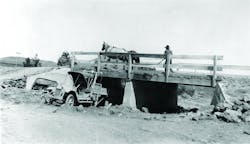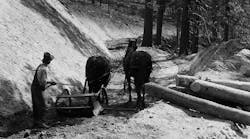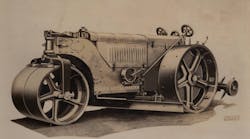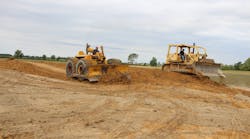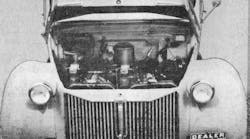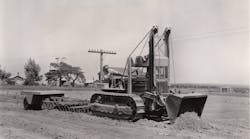On occasion, a situation will arise in which a scraper is the ideal excavating machine, but a dump truck or a larger off-highway hauler is better for transporting the spoil.
Such circumstances have apparently been around since the advent of these machines. A photograph from a 1928 catalog (above) showed one means of doing this. The details are a little unclear, but the truck was driven under a wooden A-frame and loaded from a slip scraper pulled up one side of the structure. To judge by the pile of stones at the base of the A-frame, there was apparently a means of screening or sorting the material.
Three things are unexplained about this image. One is that the horses appear to be pulling a wheeled scraper chassis with no bowl; perhaps the “slip scraper” that is barely visible on the A-frame’s incline is the bowl of the wheeled scraper, detached for the trip up the ramp and ready to be re-mounted when it returns to the ground. Second is just how the scraper was raised and lowered. This author’s guess is that this was done by a winch; a length of wire rope that these scrapers would not normally use is visible above the incline. Finally, consider the location of the chassis and its team and teamster. Their prominent and clearly posed location is illogical in relation to surmised operation of this rig, and so may be intended to imply the use of such a scraper as the excavator.
The more common means of loading trucks with a scraper was to simply pull the scraper over a bridge or deck and have it discharge its payload into a charging hopper, or simply into the truck bed itself (right). This could be done by the scraper being on a fill, digging a pit or slot for the truck to drive into while the scraper worked on grade, or both.
The scrapers could also charge a conveyor belt that transferred the spoil to the trucks.
What may be the largest-scale application of this technique occurred in the late 1960s when Anaconda Copper Co. removed 200 million tons of overburden from its Twin Buttes Mine near Garden Valley, Ariz. Anaconda achieved a staggering average production of 300,000 tons per day by excavating the material with 52 Caterpillar motor scrapers, mostly 40 yard-struck 660s and 666s. The scrapers discharged to the conveyor transfer hopper two abreast, and the 60-inch-wide conveyor forwarded it to another set of hoppers. Twenty-nine more Cat 660 tractors pulling 100-ton/55-yard-struck capacity Athey bottom-dump wagons loaded side by side from these hoppers and hauled the overburden to the spoil banks.
The Historical Construction Equipment Association (HCEA) is a 501(c)3 nonprofit organization dedicated to preserving the history of the construction, dredging and surface mining equipment industries. With more than 4,000 members in 25 countries, activities include operation of National Construction Equipment Museum and archives in Bowling Green, Ohio; publication of a quarterly magazine, Equipment Echoes, from which this text is adapted, and hosting an annual working exhibition of restored construction equipment. Individual memberships are $30 within the U.S. and Canada, and $40 elsewhere. Information is available at www.hcea.net, 419.352.5616, or [email protected].
